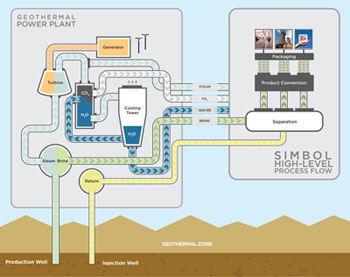Tesla’s Gigafactory is already spurring a new business that’s vying to supply it.
A startup company called Simbol is in the final stages of raising funds for a factory that would open in 2017 – the same year as Tesla’s world’s largest battery plant.
Simbol’s California plant – which breaks ground this summer – would be the first to create lithium by extracting it from geothermal power plant waste. The company is
partnering with geothermal power producers in a mecca for that kind of energy – Southern California’s Imperial Valley.
Tesla’s plant will need lots of lithium to make batteries. At 30 gigawatt-hours of annual capacity, it will consume more lithium than produced worldwide in 2013. And demand for lithium is growing for other energy storage applications as well as for consumer electronics.
Luckily, geothermal, which has lagged other renewable energy sources, is finally growing. It will also be the sole power source for Sonoma Clean Power, a new municipal utility, and projects are popping up in a majority of countries. Geothermal surpassed 12 gigawatts (GW) last year and there are 30 GW in the pipeline, according to the industry’s trade association.
"In numerous countries across Latin America, East Asia, Southeast Asia, geothermal is not just an option for renewable power but is the least-cost option for power generally, better than coal, gas and hydro," Mark Taylor from New Energy Finance told Bloomberg. "If a country has plentiful and powerful geo resources, geo will be highly competitive with all power and generally represent a growth opportunity."
Sustainable Lithium
If lithium can be produced as a byproduct of geothermal energy, that would make a more sustainable battery. The standard way of making lithium is by mining it from hard rock or through a complex process of slowly evaporating sea water,
concentrating it into brine, and then using chemicals to separate the resulting lithium from salt, water and various solids.
Instead, Simbol would make lithium from brine that’s a byproduct of geothermal power production. Since 2011, it’s been operating a pilot plant in Calipatria, California where it extracts lithium from the brine of a 50 megawatt geothermal plant.

"The brine comes out of the ground, electricity is produced, elements will be taken out of the stream, and the brine will go back in the ground," Joseph Lowry, Vice President at Simbol, explains to the New York Times.
Since the soil stays at a steady temperature, the brine is preheated as it leaves the ground, reducing the energy costs of producing lithium, and since the brine is returned underground there’s no need for environmental mitigation.
And to get access to the brine, Simbol simply bolts onto geothermal plants.
Simbol says the plant will be able to produce 15,000 metric tons
of lithium a year along with other minerals from the most prolific brine source in the world. The result is a "transformational method for competitively producing the highest performing materials from a secure, scalable, and sustainable resource base," the company says. "With our proprietary bolt-on technology, Simbol and the Salton Sea will yield many decades of lithium, manganese, and zinc, securing our critical materials future."
Rare Earths Dilemma
That would help solve a dilemma for the cleantech industry, which relies on these rare earth minerals for everything from electric cars to wind turbines. Right now, 90% of those minerals are mined in China in an exceedingly toxic process.
But what about graphite, another critical component of batteries and consumer electronics? China is closing dozens of graphite operations down as it attempts to reduce pollution in the country. Australia plans to open a mine, but there’s still concern about rising prices for batteries, which otherwise are dropping.
Extremely corrosive hydrochloric acid used to process graphite into usable form. If the acid is released into the environment as waste water, it is harmful to all forms of life.
An electric car has a lot of graphite, about 110 pounds. Next come hybrid cars with 10 kilograms and e-bikes with 1 kilogram. In terms of consumer devices, laptops have 100 grams and mobile phones about 15 grams.
Tesla’s factory could alone double demand for graphite in batteries, requiring the equivalent of six new mines to enter production.
Knowing the situation, the company announced it would source all minerals from the US. The vast majority Tesla uses is synthetic – not mined – and comes from Japan and Europe right now, she says.
"It will enable us to establish a supply chain that is local and focused on minimizing environmental impact while significantly reducing battery cost," Liz Jarvis-Shean of Tesla told Bloomberg.
The Department of Energy’s ARPA-E program has funded a Batteries and Energy Storage Hub with $120 million to find alternatives to rare earths that also bring down the price.
